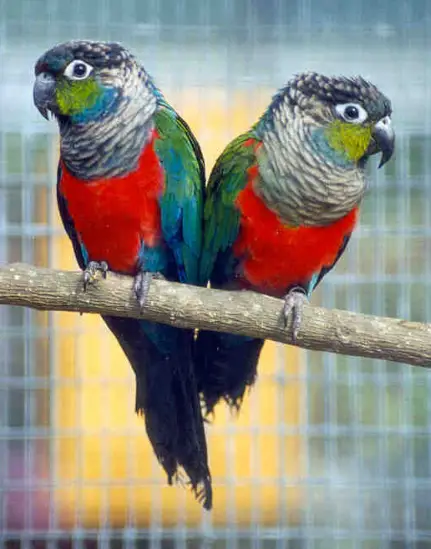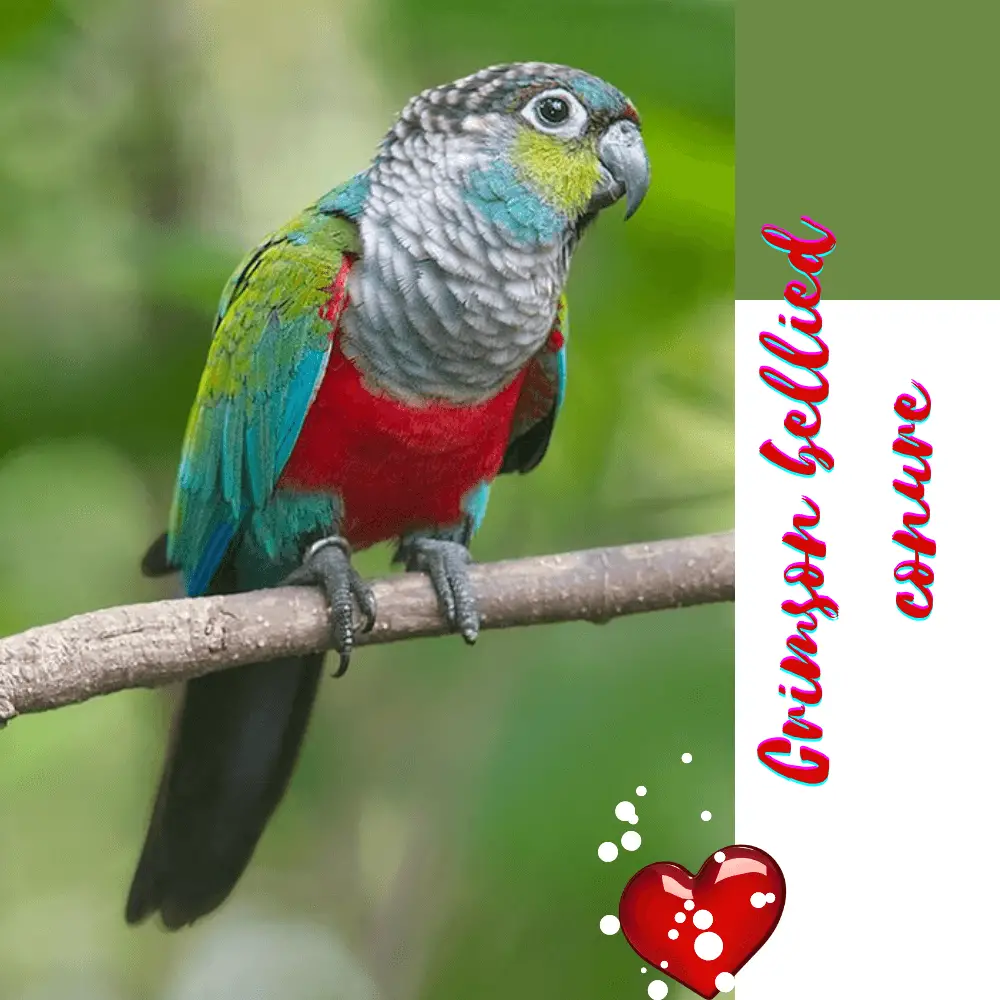The Crimson bellied conure ( Pyrrhura perlata, Syn .: Pyrrhura rhodogaster ) belongs to the genus of the red-tailed parakeets ( Pyrrhura ).
Fire-bellied parakeets are extraordinarily colorful birds, which is already indicated by their species name “Perlata”, which translated from Latin means “thrown”.
The area of origin of the birds is in South America, more specifically northern Brazil and northern Bolivia.
There they live in the dense vegetation of the rainforest. The Crimson bellied conures mostly stay in the higher parts of the trees.
They have often seen together with the Red- headed Parakeet ( Pyrrhura picta ). Outside the breeding season, fire-bellied parakeets usually travel in small flocks of three to eight individuals.
Fire-bellied Parakeets used to be common in the wild, but since 2012 they have been listed as “Vulnerable” on the Red List.
Until a few years ago, they were rarely found in human care. Due to their particularly beautiful coloring, however, they are now among the most commonly kept Pyrrhura species.
Description

Crimson bellied conures grow to about 24 cm and weigh 85 to 95 g. Their physique is rather strong and compact.
Males and females are indistinguishable from the outside. An endoscopy or a DNA determination is required for an exact sex determination.
The plumage of the fire-bellied parakeet is predominantly green. However, the fire-bellied parakeet owes its name to its bright red belly.
The wing tip, under the breast, and underwing coverts are also colored in this striking red. There is a narrow red stripe at the base of the beak.
The Crown, forehead, neck, upper breast, nape, and back of the head are dull brown, with each feather edged with whitish brown.
The nape is marked by a blue band. Reins and cheeks are yellow-green, while the ear-coverts are brownish-white.
Thighs, under tail-coverts, upper wing-coverts, palms, and primaries are blue, while the top of the tail is brown-red and the underside of the tail is gray.
The white eye-ring is bare and the iris is dark brown. The sharp beak and feet are grey.
The young birds look like their parents, but their plumage colors are not yet as bright and their bellies are green. They are usually fully colored by around eight months, although the period can vary by a few months.
Subspecies
In more recent publications, no subspecies are assigned to the fire-bellied parakeets. In some older publications, however, the Crimson bellied conures are combined with the blue-bellied parakeets into one species, with corresponding subspecies.
Crimson bellied conure Behavior
The Crimson bellied conure is a very agile bird that, like many Pyrrhura species, like to bathe. It belongs to the medium-voiced parrots. However, when threatened and when excited, they scream very loudly.
Crimson bellied conure personality
Crimson bellied conures have not been kept and bred in Europe for very long. The first specimens arrived in Europe in the 1820s,
but it was not until 1983 that the first breeding succeeded in Germany. In the meantime, however, beautiful parakeets can be found in many aviaries.
Crimson bellied conures should never be kept as solitary animals, as they are very sociable birds with a pronounced social behavior, just like other parrots.
They are very playful and do almost everything together. Keeping them in pairs seems ideal, but keeping them in a small swarm is also possible under certain circumstances since they are not very aggressive towards their conspecifics outside the breeding season.
If there is enough space, they can be kept together in small flocks. During the breeding season, however, it shows a pronounced territorial behavior and tends to be quite aggressive. Keeping them together during breeding and courtship is therefore not recommended.
Since Crimson bellied conure is a very active parrot, they need a lot of space. If they are kept in a cage, they need several hours of free flight every day.
If kept in an aviary, this should be at least 3 m long in order to take account of the parakeets’ pronounced need to fly.
Even if today’s offspring are relatively robust and no longer as sensitive as the imported birds, they cannot tolerate temperatures below 10 °C, which is why Crimson bellied conures need a heated shelter in an outdoor aviary. A sleeping box should be made available to the birds overnight all year round.
Crimson bellied conure breeders
SOURCE: Beth Lee
Diet
In the wild, Crimson bellied conures feed mainly on fruits, flowers, berries, seeds and nuts. When feeding in human care, this should be taken into account by covering at least 40% of the daily requirement with fruit and vegetables.
The basis of the feed is a grain mixture for large parakeets with as few sunflower seeds as possible.
In addition, branches should be given to gnaw on, as this species of parakeet has a strong need for nails.
Crimson bellied conure breeding
Fire-bellied parakeets are regularly kept in human care. Their breeding is relatively easy. During the breeding season, however, the breeder should separate the pairs, otherwise they will interfere with each other’s incubation.
Young Crimson bellied conures are capable of breeding at about twelve months, but they should not be bred at this early stage.
Young females are more likely to have problems laying eggs, and young males are often not reliable in caring for their mates and young.
The breeding pairs like to choose between portrait and landscape nest boxes. Many couples prefer a natural log cave.
The females lay three to seven eggs two days apart, which are incubated for 23 days. The nestlings are cared for by both parents.
The chicks leave the nest when they are around 50 days old, after another three weeks they are ready to feed and independent. When ringing, a ring size of 5.5 mm should be used.
Crimson bellied conure vs green cheek
SOURCE: Parrot Bliss
Conservation Status
All Pyrrhura species must be reported to the local authorities. In most federal states, the lower nature conservation authority is responsible, but in North Rhine-Westphalia, it is the environmental agency.
Registration is free. You need a form that is available either online or directly from the authority.
Furthermore, you have to present a certificate of origin from the breeder, which proves that the purchased parakeet comes from a legal European offspring. The ring number and the sex of the bird must also be given.
If a parakeet does not come from the EU, a CITES certificate is required.

